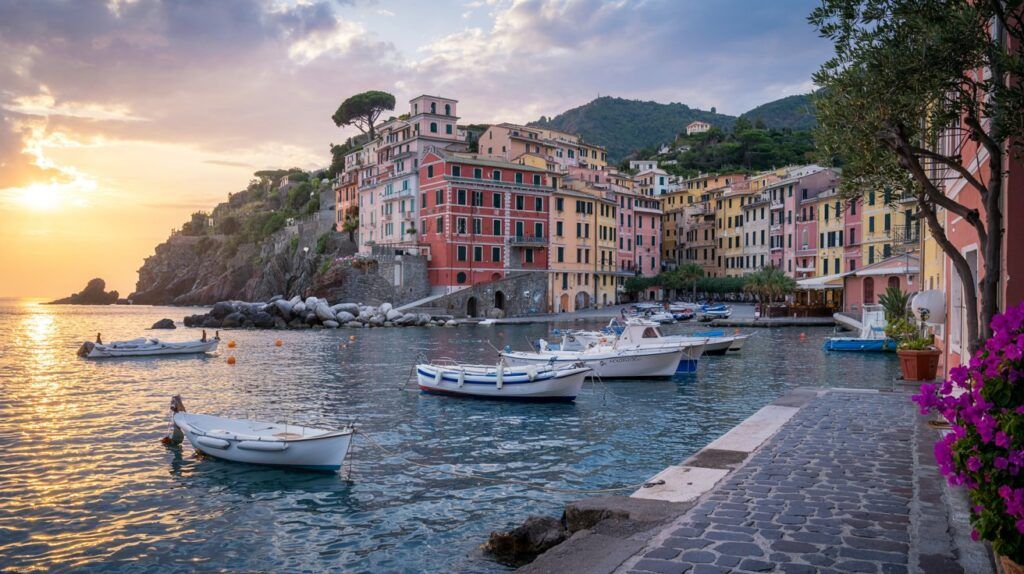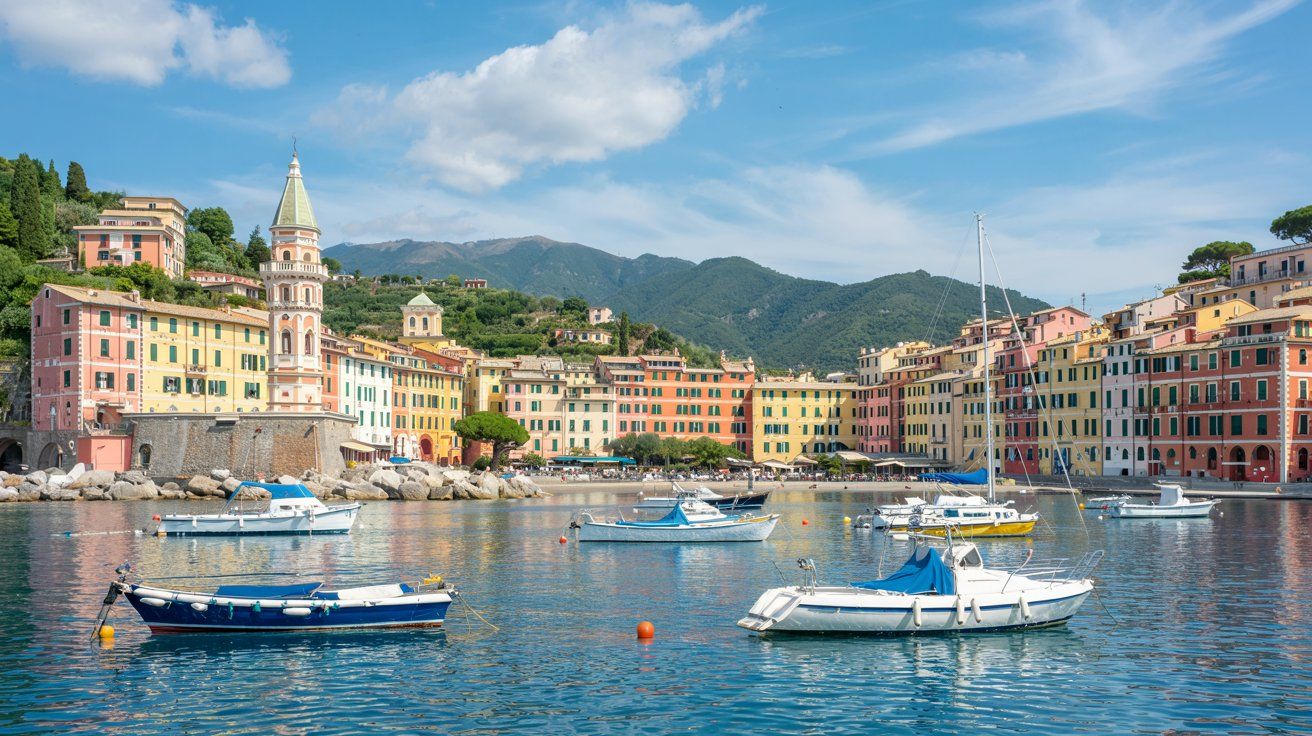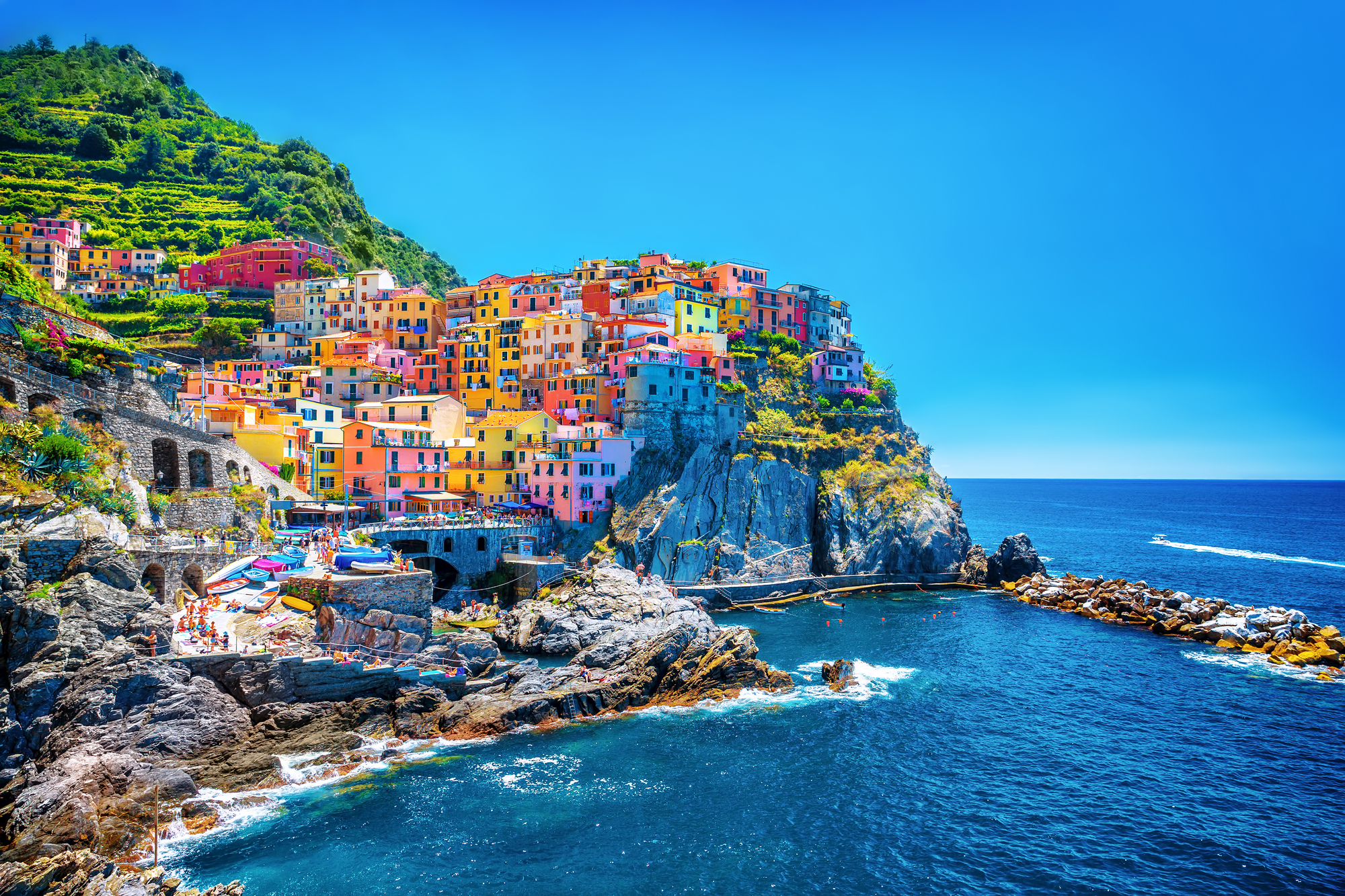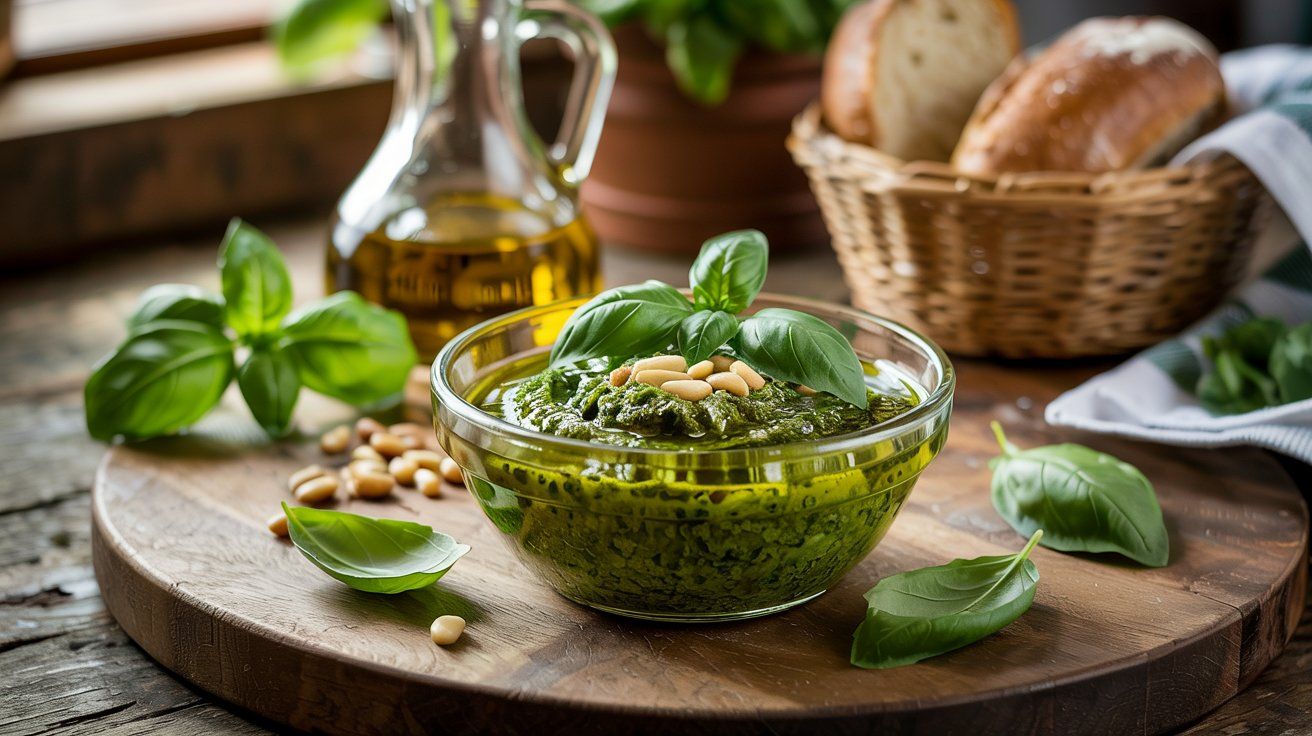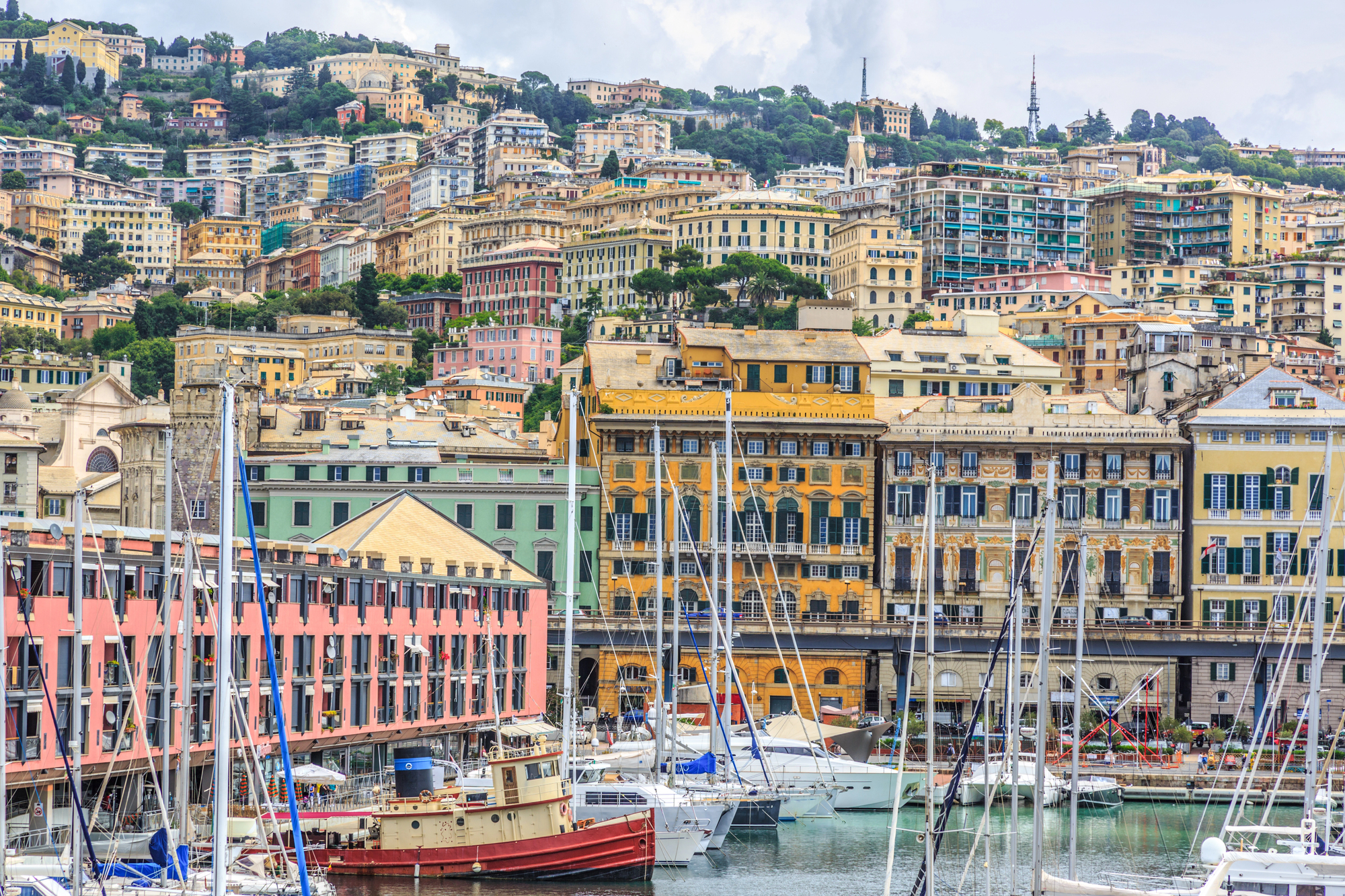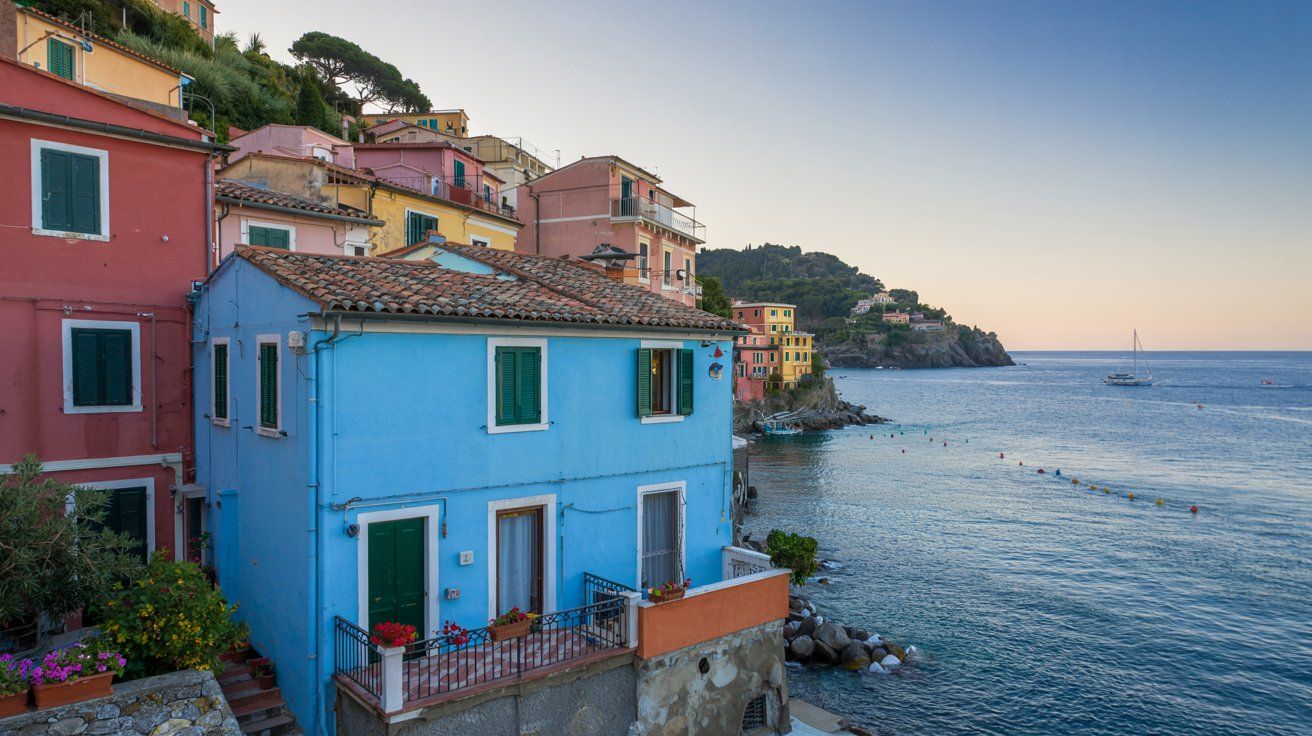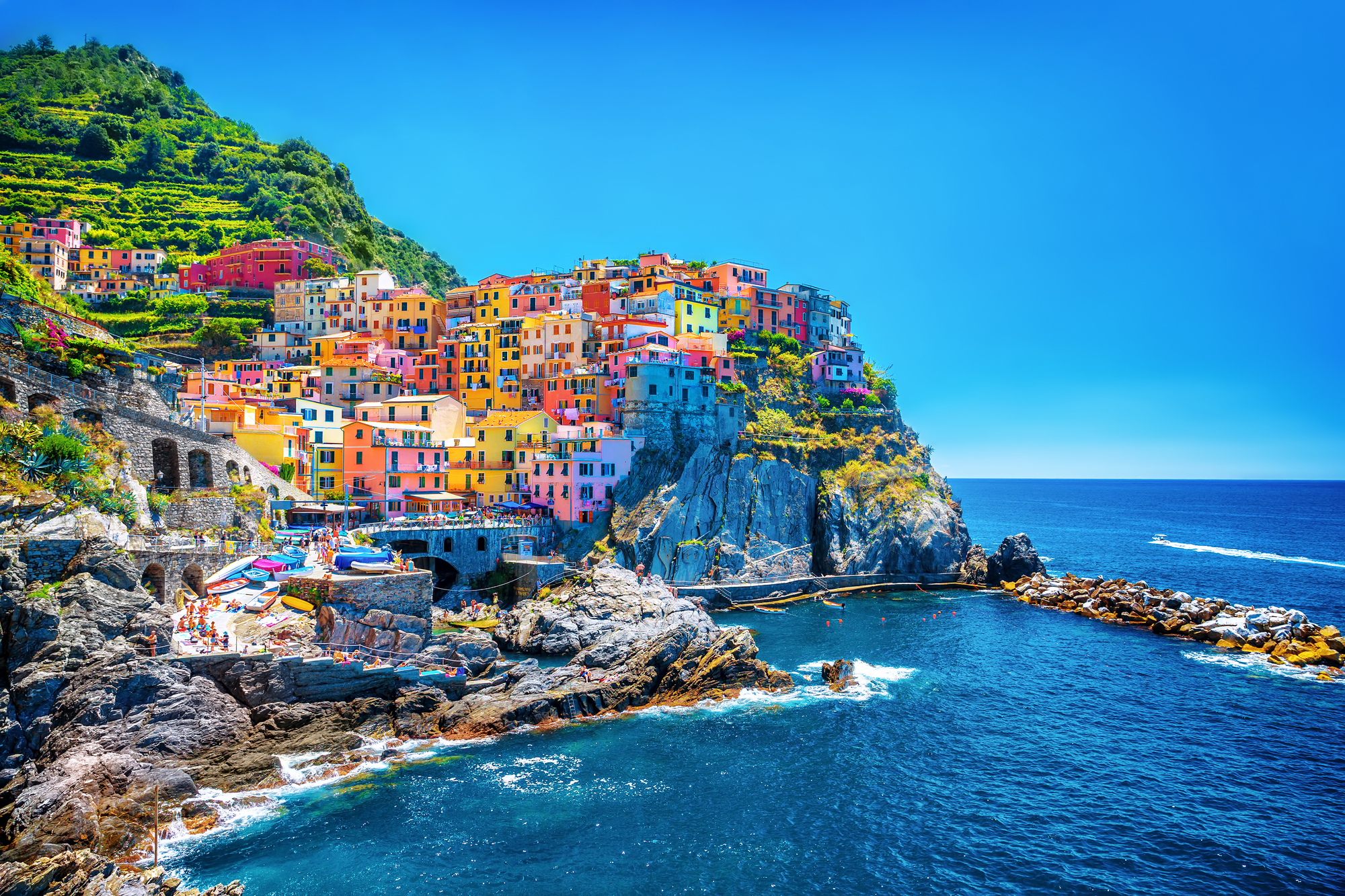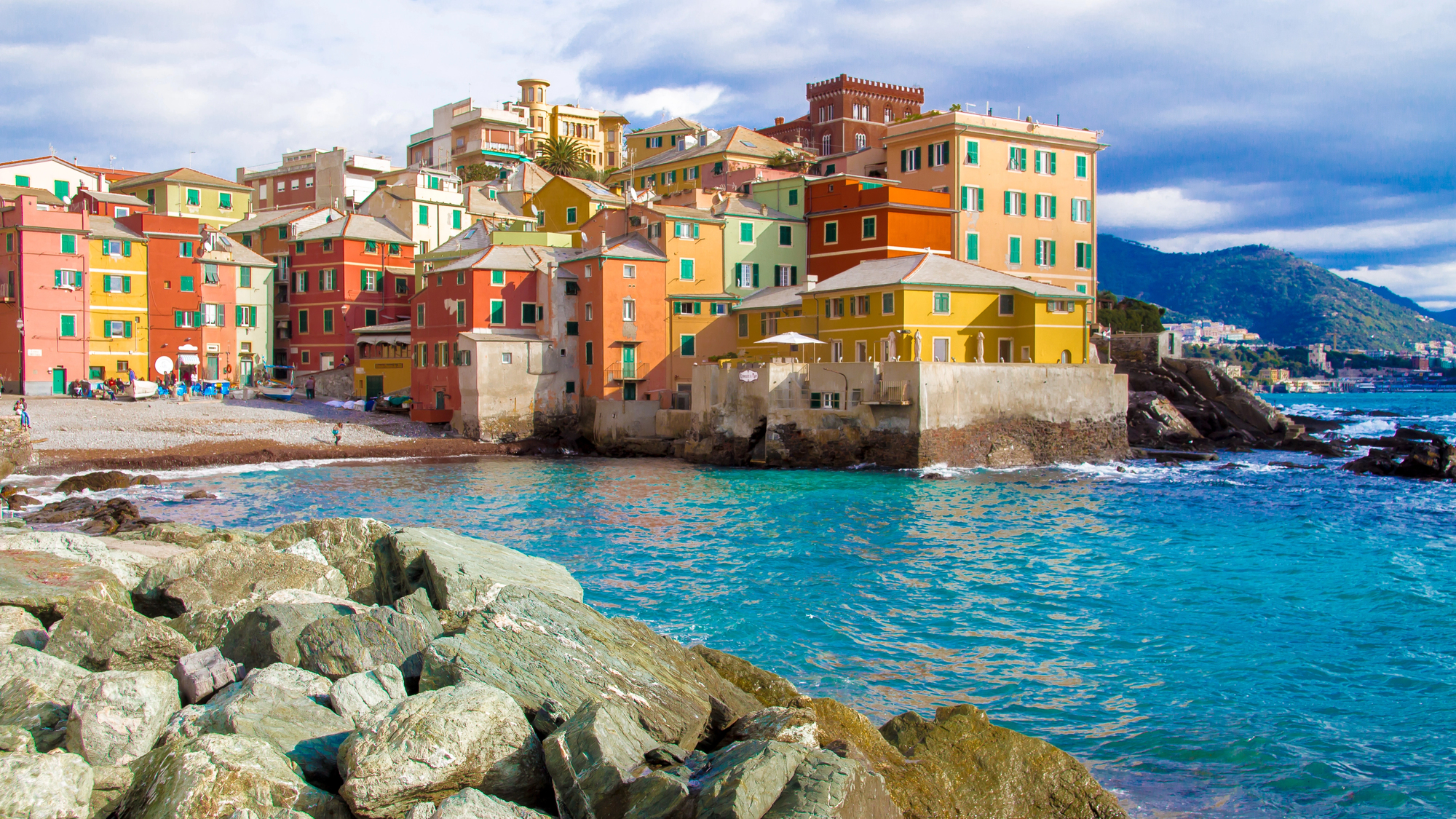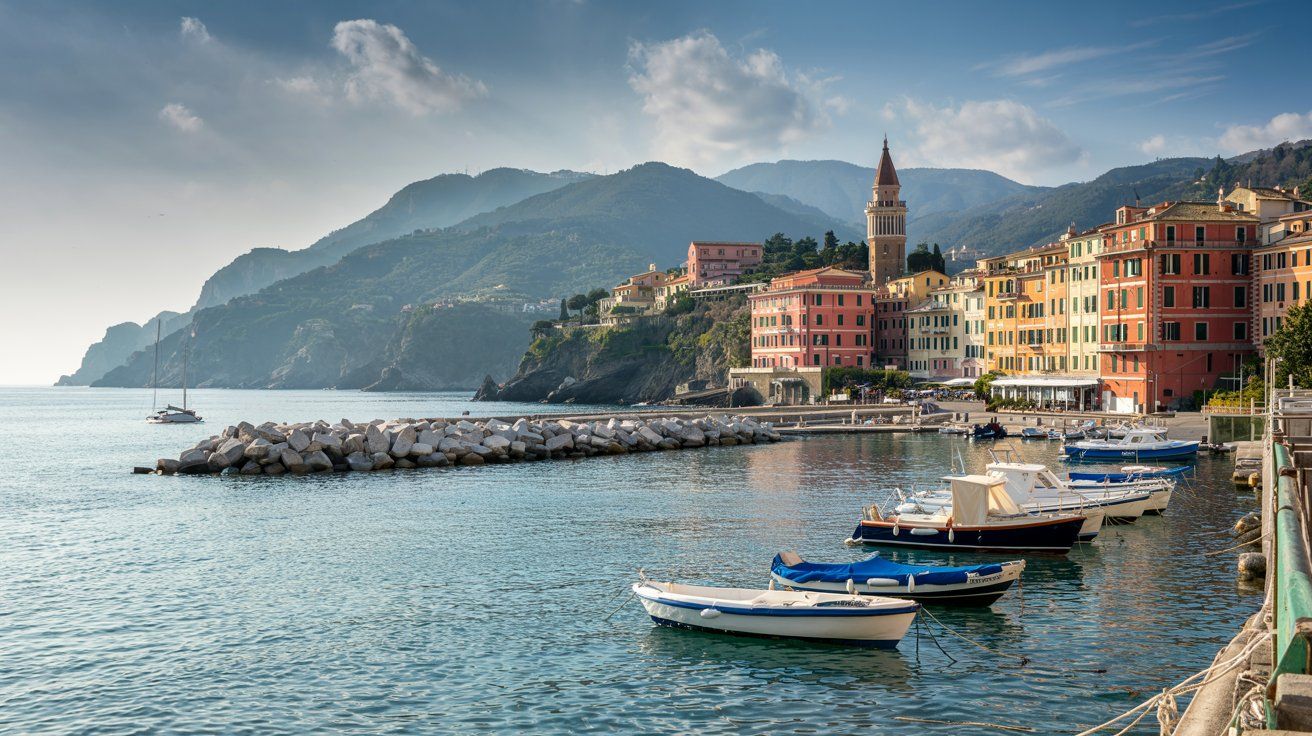The Italian Riviera, squeezed between the Ligurian Sea and rugged mountain chains, has a maritime history that stretches all the way back to ancient Roman times. This gorgeous stretch of coast—its name literally means “shoreline” in Italian—covers almost all of Liguria’s coastline and, if you go back far enough, even reached into what’s now France. The region really took off in the Middle Ages, when the Republic of Genoa carved out a reputation as a maritime republic from 1099 onward, going head-to-head with Venice for control of Mediterranean trade.
Today, people flock to see the Riviera’s colorful towns and beautiful beaches, but back then, it was a bustling hub of commerce and naval might. Genoa thrived on maritime trade, which poured wealth into the region and left its mark on the area’s architecture and cultural vibe. That historical influence still lingers in the Italian Riviera landmarks that travelers love today.
Get a discount of 15% to 70% on accommodation in Genoa! Look for deals here:
Genoa Hotels, Apartments, B&Bs
The idea of a “riviera” as a glamorous, resort-studded coastline took shape here, thanks to the area’s unusual geography and storied past. Liguria’s tucked-away spot between mountains and sea gave rise to a culture that managed to stay somewhat sheltered over the centuries, holding on to old traditions but also picking up new ones from the traders and travelers who drifted through its ports.
Geographical Overview of the Italian Riviera
The Italian Riviera hugs the Ligurian coast in northern Italy, forming a graceful arc of land between the sea and the mountains. It’s a region where jaw-dropping views, a mild climate, and a lively cultural scene all blend together.
Borders and Main Regions
The Italian Riviera runs from Ventimiglia, right at the French border, to La Spezia, near Tuscany, covering Liguria’s entire coastline. Locals usually split it into two main parts: the Riviera di Ponente (“Coast of the Setting Sun“) stretches west from Genoa to France, while the Riviera di Levante (“Coast of the Rising Sun“) heads east from Genoa to La Spezia.
The Riviera di Ponente takes in the provinces of Savona and Imperia, with broader beaches and towns like San Remo and Alassio that draw sun-seekers. The Riviera delle Palme (“Palm Riviera”) is part of this western stretch, and it’s famous for its palm-lined seafronts.
The Riviera di Levante is all about dramatic scenery—think steep cliffs and tiny coves. Here, you’ll find the iconic Cinque Terre villages and upscale spots like Portofino and Santa Margherita Ligure.
Major Cities and Towns
Genoa (Genova) sits at the heart of Liguria and splits the Riviera in two. This old port city once ran the show as a powerful maritime republic, with influence that reached far across the Mediterranean.
On the Ponente side, towns like San Remo (famous for its music festival and flowers) and Imperia (known for olive oil) stand out. Alassio and Finale Ligure are also popular for their beaches and historic old towns.
The Levante side is home to the five colorful fishing villages of Cinque Terre—Monterosso, Vernazza, Corniglia, Manarola, and Riomaggiore. There’s also swanky Portofino, the postcard-perfect buildings of Camogli, and Rapallo’s cozy harbor.
Sestri Levante, Portovenere, and Lerici add even more charm, each with their own unique story and vibe.
Physical Features and Climate
Mountains crowd right up to the sea along the Riviera. The Maritime Alps and Ligurian Apennines shield the coast from chilly northern winds.
Thanks to this natural barrier, the region enjoys a Mediterranean microclimate—winters are mild, summers are warm and sunny. Winter temperatures rarely dip below 10°C (50°F), and in summer, you’re looking at 25-30°C (77-86°F).
The coastline flips between rocky headlands and tucked-away sandy coves. The eastern stretch is especially dramatic, with cliffs plunging straight into the Ligurian Sea.
Hillsides are dotted with olive groves, vineyards, and citrus trees. Pine forests and Mediterranean brush thrive in the gentle climate. The Ligurian Sea’s clear blue water makes for fantastic swimming and sailing for most of the year.
Early History and Ancient Civilizations
The Italian Riviera’s story reaches back thousands of years. Different peoples and cultures have left their marks along this stretch of Liguria. From prehistoric cave dwellers to the Ligurian tribes and finally the Romans, this area has always been a crossroads.
Prehistoric Settlements
Humans have lived along the Italian Riviera since the Paleolithic era. Caves like Balzi Rossi near Ventimiglia hold artifacts from 40,000 years ago—evidence that people have called this coast home for a very long time.
By the Neolithic period (6000-3000 BCE), people began settling down, farming, and building more permanent homes. Archaeologists have found stone tools, pottery, and the remains of simple dwellings scattered across Liguria.
During the Bronze Age (2000-900 BCE), coastal communities started to build trading networks across the Ligurian Sea. These early settlements set the stage for bigger maritime centers like Genoa.
Cave paintings and carvings in the hills give us small glimpses into the beliefs and daily lives of these ancient people.
Ligurian Tribes and Influences
The Ligurians, an Indo-European tribe, ruled the region from about 2000 BCE to 200 BCE. They built hilltop settlements to keep watch over the coast and protect themselves.
These folks had a reputation for independence and didn’t like outsiders telling them what to do. They developed their own traditions and traded with Etruscans and Greeks.
Ligurian tribes organized themselves into clans and managed to farm olives, grapes, and grains on steep hillsides—a practice you can still spot along the Riviera today.
Their language and customs shaped the region, even if much of their culture later blended into those of more dominant civilizations.
Roman Rule and Legacy
Romans took over Liguria in the 2nd century BCE after fierce local resistance. They built important settlements like Genua (Genoa), Albingaunum (Albenga), and Luna (near today’s La Spezia).
They constructed the Via Aurelia, a major road that linked the whole coastline to Rome. This changed everything, making trade and travel much easier and bringing new prosperity to the area.
Roman engineers left their mark with aqueducts, bridges, and city layouts. You can still spot some of these ancient structures in places like Ventimiglia and Albenga.
Under Roman rule, maritime trade boomed. Ligurian ports became gateways to Gaul and Hispania, and the Riviera’s natural harbors turned into key links in Rome’s trading empire.
By the time the Western Roman Empire fell in 476 CE, Roman culture had seeped deep into local traditions, language, and architecture along the Riviera.
Medieval Era: Maritime Power and Trade
During the Middle Ages, the Italian Riviera shifted from scattered coastal villages to a major player in Mediterranean trade and naval power. Genoa, especially, rose to the top, building a reputation that would last for centuries.
The Rise of Genoa
Genoa’s rise kicked off in the 11th century when it broke free as an independent maritime republic. The city quickly started expanding its reach along the Ligurian coast. Thanks to its natural harbor and prime location, Genoa put together a formidable fleet to guard its commercial interests.
Genoese merchants and sailors built a reputation for skill and guts. The city’s leaders poured resources into shipyards, turning out ships that could haul cargo and fend off pirates.
By the 12th century, Genoa controlled most of the Ligurian Sea coast. The republic set up a sophisticated banking system to fund trade missions, making Genoa Travel Guide a magnet for merchants from all over Europe.
Trade Routes and Strategic Importance
Genoa’s traders mapped out routes linking Europe with North Africa, the Middle East, and later the Black Sea. Spices, silk, and precious metals passed through Ligurian ports, bringing serious wealth to the region.
They set up trading colonies in far-off places, creating a web of outposts from Spain to Crimea. These outposts secured Genoa’s trading privileges and gave their ships safe places to dock.
The Riviera’s smaller towns, like Savona, Portofino, and the Cinque Terre villages, also thrived as secondary ports.
Because the mountains made farming tough, Liguria leaned into the sea for survival. That challenge ended up being a blessing, pushing Genoa to double down on ships and trade.
Rivalries and Conflicts
Venice, another maritime giant, was Genoa’s biggest rival. The two cities fought hard for trade routes, naval dominance, and influence across the Mediterranean.
The War of Chioggia (1378-1381) was one of the fiercest showdowns. Neither side really won, but Genoa showed it could hold its own at sea.
Closer to home, Genoa tangled with Pisa, another seafaring power. By the late 1200s, Genoa had beaten Pisa, knocking out a major competitor.
Internal strife wasn’t uncommon. Powerful families like the Doria, Spinola, Grimaldi, and Fieschi often battled for control, sometimes violently. These power struggles could weaken Genoa, especially when the city faced threats from outside.
Renaissance and Cultural Development
The Renaissance brought a burst of energy to the Italian Riviera. Maritime trade and cultural exchange took off, and local noble families poured money into artistic projects. Genoa, in particular, became a hotbed for new architecture and literature.
Art, Architecture, and Literature
During the Renaissance, the Riviera—especially Genoa—saw a wave of artistic creativity. The city’s wealthy merchants bankrolled grand palaces and churches, using bold colors and trompe l’oeil effects that you can still see today.
Writers like Percy Bysshe Shelley and Lord Byron visited the Riviera, soaking up its landscapes and leaving their mark. Their stays kicked off a tradition of artists coming here for inspiration.
Local painters developed a Ligurian style that mixed maritime scenes with religious themes. If you wander into churches around the region, you’ll spot these unique frescoes and altarpieces.
Noble Families and Patronage
Big-name families like the Dorias, Spinolas, and Grimaldis drove the Riviera’s Renaissance scene. They made fortunes from trade and banking, then spent lavishly on art and architecture to show off their status.
In Genoa, their investments created the stunning Strada Nuova (now Via Garibaldi), lined with palazzi that are now UNESCO World Heritage sites. These buildings stand as some of the best examples of Renaissance urban design in Liguria.
These families also backed scientific breakthroughs and maritime exploration. Their money helped develop new navigation techniques and maps, keeping Genoa at the cutting edge of seafaring.
Rivalries between families fueled even more creativity, as each tried to outdo the others with ever more impressive buildings and public works.
Modern History and Unification
The Italian Riviera changed dramatically during the 19th century, moving from a patchwork of territories to becoming part of a unified Italy. At the same time, it started to draw European travelers looking for something special along the coast. It’s wild to think how quickly it all happened—one moment, fragmented states; the next, a premier destination on everyone’s map.
Napoleonic Era and Political Changes
Napoleon’s campaigns shook up the Ligurian political scene in the early 1800s. The Republic of Genoa had ruled most of the Riviera for ages, but Napoleon dissolved it and set up the Ligurian Republic under French control.
When Napoleon fell in 1815, the Congress of Vienna handed Genoa and the Ligurian coast over to the Kingdom of Sardinia, under the House of Savoy. Suddenly, the old maritime republic became just one part of a much larger northern Italian state.
During this time, the region’s economy started to shift. Maritime trade, once the backbone, faded, and new opportunities sprang up in manufacturing and early tourism across coastal towns.
Unification of Italy
By the mid-19th century, the Risorgimento (“resurgence”) movement picked up steam, pushing for a unified Italy. Ligurian intellectuals and regular folks alike threw their support behind the nationalist cause.
The Kingdom of Sardinia, which included the Riviera, led the charge under Count Camillo di Cavour and King Victor Emmanuel II. By 1861, most of the peninsula had united under one Italian kingdom.
In 1870, Italian troops took Rome from the Papal States, finishing the unification process. Genoa, as a major port, quickly became central to the new Italian state.
Genoa’s industry took off during this period, and the city turned into one of Italy’s busiest commercial hubs.
Early Tourism Development
Tourism on the Italian Riviera started to take off in the early 19th century. The mild climate lured European aristocrats who wanted to escape harsh northern winters.
British travelers, always trendsetters it seems, played a big role. In 1834, Lord Brougham landed in Cannes (just next door on the French Riviera) to dodge a cholera outbreak in Nice, and soon enough, the whole coast became fashionable. The Italian side saw similar changes.
Towns like San Remo and Portofino, once just fishing villages, turned into fashionable resorts with grand hotels and elegant promenades. When the railways arrived in the late 19th century, the region opened up to even more visitors.
By the early 20th century, the Riviera had built a reputation as a top Mediterranean getaway, attracting artists, writers, and wealthy vacationers from all over Europe and America.
The Italian Riviera in the 20th Century
The 20th century brought huge changes to the Italian Riviera. It shifted from an exclusive playground for European elites to a tourist destination that welcomed everyone. The region saw the devastation of war, but also an impressive economic revival.
Second World War and Its Impact
World War II hit the Riviera hard. After Italy surrendered to the Allies in 1943, German troops moved in and occupied the area. Genova and La Spezia, both key ports, got hammered by bombing raids.
Soldiers built bunkers and coastal defenses along the shore, and you can still spot some of them today. The naval base at La Spezia became a prime target, and a lot of historic buildings didn’t survive.
San Remo and nearby towns sheltered displaced people, but they also faced food shortages and tough times. With transportation networks destroyed, many communities found themselves cut off.
Locals wasted no time after the war—they started rebuilding right away. They restored the battered harbors in Genova and La Spezia, paving the way for the region’s economic comeback.
Economic and Social Changes
After the war, the Riviera’s economy began to shift. Tourism, once reserved for the elite, opened up to the masses. Visitors from all over Europe—and beyond—started arriving in droves.
Towns like San Remo modernized their waterfronts with new hotels and amenities. The San Remo Music Festival, launched in 1951, put the town on the international stage.
Meanwhile, the fishing industry in places like Imperia and Savona shrank, and service jobs took over. Still, traditional agriculture—especially olive and flower cultivation—remained important.
Better roads and expanded railways made the Riviera easier to reach. That brought more visitors, but also new challenges, as some towns struggled to hang on to their historic character amid all the modern development.
Tourism and International Appeal
Starting in the mid-19th century, the Italian Riviera transformed from a sleepy stretch of coast into a world-famous vacation spot. Its climate, landscapes, and culture still draw people from everywhere.
Growth of the Tourism Industry
Tourism really started booming in the late 19th century. The Riviera became a go-to winter escape for Europe’s upper crust. Wealthy travelers, especially from Britain, flocked to the coast for its gentle weather and stunning views.
Writers and artists helped put the place on the map. Percy Bysshe Shelley and Lord Byron, for example, visited early on and raved about the scenery. Their stories kicked off a tradition of celebrity visitors that’s still going strong.
The Riviera developed its own tourism zones:
- Riviera di Ponente: The west coast, with towns like Alassio and Finale Ligure, became a laid-back beach destination.
- Riviera di Levante: The east, with Portofino and Cinque Terre, attracted those in search of picturesque villages and a bit of exclusivity.
Sanremo, Rapallo, and Santa Margherita Ligure all grew, adding grand hotels and promenades to welcome more guests.
Cultural Experiences and Festivals
The Riviera isn’t just about beaches and sea views. Local festivals keep centuries-old traditions alive, and visitors get a real taste of Ligurian culture.
Food and wine are a huge part of the experience. You’ll find:
- Fresh seafood paired with local Vermentino wine
- Classic pesto Genovese made from Ligurian basil
- Focaccia and farinata (a chickpea flatbread)
Smaller towns like Camogli and Sestri Levante still honor fishing traditions alongside tourism. Camogli’s Fish Festival in May is a lively event where locals cook up fish for thousands in enormous pans.
The region manages to balance tourism and preservation. Cinque Terre, for instance, limits visitor numbers to protect its fragile landscape but still welcomes travelers. Portofino stays exclusive yet keeps its colorful harbor and traditional vibe.
Cuisine and Local Products
The Italian Riviera’s food scene blends the freshness of the sea with flavors from the mountains. Simple ingredients, classic techniques, and a sense of tradition define the region’s dishes.
Regional Food and Wine Traditions
Liguria, which forms the Italian Riviera, gave the world focaccia—a fluffy, versatile flatbread you’ll spot in every bakery. The region is also famous for pesto alla genovese, a bright green sauce made with local basil, pine nuts, garlic, Parmigiano-Reggiano, and olive oil.
Seafood is everywhere here. Anchovies, squid, and sea bream show up in dishes like ciuppin (a hearty fish stew) and burrida (fish in walnut sauce).
Pasta lovers will find trofie (twisted pasta) and pansoti (stuffed pasta) on many menus, often served with walnut sauce or, of course, pesto.
Terraced vineyards produce unique wines like Vermentino and Rossese. These crisp, mineral-driven wines pair perfectly with the local seafood.
Olive Oil Production
Steep hillsides along the Riviera are blanketed with ancient olive groves. The Taggiasca olive, small but packed with flavor, dominates here.
Cooks in the region rely on these delicate, buttery oils, which have a gentle fruitiness and subtle almond notes—quite different from the peppery oils of Tuscany.
Families still harvest olives the old-fashioned way, by hand or with small rakes. The terrain is so steep, machines just can’t do the job.
Cold-pressing preserves the oil’s subtle flavors and health benefits. Many producers open their doors to visitors for tastings right at the source.
Influence of Restaurants on Local Culture
Restaurants here are more than just places to eat—they’re cultural institutions. Many trattorias are family-run and stick to recipes that haven’t changed in generations.
The slow food movement, which started nearby in Piedmont, inspires a lot of Riviera chefs. They focus on local ingredients and traditional cooking methods, steering clear of mass production.
Meals are leisurely affairs, often stretching for hours. Food here is about connection and conversation, not just nourishment.
Seafront restaurants in places like Portofino and Santa Margherita Ligure mix tradition with a touch of international flair. Locals and visitors gather, sharing meals and stories in a way that blurs the lines between cultures.
Natural Beauty and Coastal Landscapes
The Italian Riviera dazzles with its dramatic coastline, where the Maritime Alps tumble into the Ligurian Sea. Colorful fishing villages perch on cliffs, turquoise water sparkles below, and terraced hillsides burst with Mediterranean greenery.
Riviera di Ponente: Western Delights
The Riviera di Ponente (“coast of the setting sun”) runs from the French border to Genoa. Here, wide sandy beaches and calm seas make it a favorite for families.
Towns like Sanremo and Alassio have palm-lined promenades and gentle hills covered in olive trees and vineyards.
The Maritime Alps shelter the coast from cold winds, creating a microclimate where even tropical plants thrive in winter.
Pastel-colored fishing villages dot the shore, their houses popping against the blue sea—a scene that never really gets old.
Riviera di Levante: Eastern Wonders
East of Genoa, the Riviera di Levante gets rugged. Cliffs plunge into the sea, and small pebbly coves hide between dramatic rock faces.
The Cinque Terre steals the show here—five villages clinging to steep, terraced hillsides, each one looking like it might just slide into the water (but somehow never does).
Further east, the Gulf of Poets boasts elegant towns like Portovenere and Lerici. Writers like Byron and Shelley fell in love with the place, and honestly, it’s easy to see why.
Terraces filled with olive trees, vineyards, and lemon groves show how people have adapted to this tough landscape for centuries.
Protected Areas and Parks
Several protected areas help keep the Riviera’s ecosystems intact. Portofino Regional Natural Park covers 1,300 hectares of Mediterranean scrub on a peninsula that juts into the sea.
Cinque Terre National Park, set up in 1999, protects the delicate balance between villages and nature. Hiking trails wind through the hills, offering jaw-dropping views.
Marine Protected Areas around Portofino and Cinque Terre safeguard vibrant underwater ecosystems. People can swim and dive in these zones, but fishing is limited to protect the wildlife.
Pine forests cover many headlands, and the scent of pine and sea salt fills the air as you wander coastal paths.
Legacy and Influence Beyond Liguria
The Italian Riviera’s influence stretches far beyond its borders, weaving connections with neighboring regions through shared history and cultural exchange. Over the centuries, these ties have sparked artistic movements and shaped the development of the wider region.
Relationship with Nice and Tuscany
The Italian Riviera has always had a close historical connection with Nice. Until 1860, Nice actually belonged to the Ligurian coast before France took over. You can still spot the similarities—in the architecture, the food, even the way people speak.
Liguria and Tuscany built their relationship through old maritime trade and a patchwork of political alliances. Back in the Renaissance, both regions buzzed with activity. Wealthy merchants from Tuscany sometimes picked the Ligurian coast for their summer getaways, which says a lot about the region’s appeal.
Mountain paths wound between these areas, letting people swap goods and stories for generations. During tough times, plenty of Ligurian families packed up and moved to Tuscany, weaving the two cultures together even more.
Cultural Exchange in the Riviera
Back in the 18th and 19th centuries, the Italian Riviera drew in international artists and writers from all over. Percy Bysshe Shelley and Lord Byron, for example, wandered the coastline, soaking up inspiration from the wild landscapes and that warm Mediterranean air.
That artistic legacy still shapes the area’s vibe today. You’ll find all sorts of literary festivals and quirky cultural events popping up, each one tipping its hat to the Riviera’s creative roots.
UNESCO gave the region World Heritage status, recognizing not only its stunning scenery but also its role as a cultural crossroads. The area has always pulled in different artistic traditions and ideas—maybe that’s what makes it feel so alive.
Step into any local museum along the Riviera and you’ll spot artifacts and artworks that tell the story of these exchanges. The region loves showing off the legacy of the international visitors who helped shape its identity.
Get a discount of 15% to 70% on accommodation in Genoa! Look for deals here:
Genoa Hotels, Apartments, B&Bs

